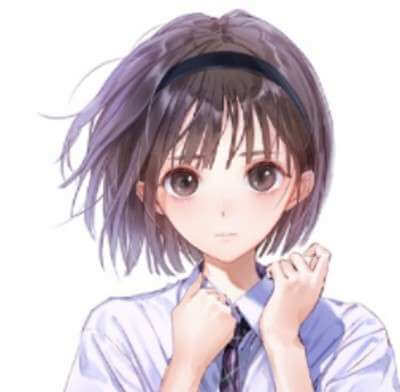Introduction
Despian is a Fusion-based archetype announced from Dawn of Majesty. Introducing themselves as the antagonist architect behind the dubious Dogmatika, the Despians bear a recurring motif of theatrical elements and corruption. Outside of trying to display their wicked intentions across the Dogmatika story, Despia brandishes a strong reliance on its Fusion-based strategy. These fallen fairies will constantly call upon their fiendish fusion overlords, which will spawn other minions upon destruction. This sort of strategy present themselves as a tempo playstyle, where your objective is to outlast your opponent to annoyance.
As the chaotic yet aesthetic nature of this archetype has fondly settled upon many rogue players including me, I would like to present a brief overview of the deck's nature.
Setting the Stage
The Despian cast consists of two moving parts, the main deck monsters with their effects to fusion summon their boss monsters. Along the way, Despia adopts a sub-archetype of Branded spell/traps to aid their mission. The usual playstyle is to develop a Fusion Monster. Upon its destruction, Aluber the Jester of Despia will revive itself, or Despian Quaeritis will summon another Despia from deck. Despia, Theater of the Branded further cements this strategy by picking up a fallen fusion, should your fairies perish from your opponent's actions. Either way, Despia will irritate the opponent with its perpetual bodies. As the game plan truly begins once a fusion monster appears on your field, players have resorted to adopting additional fusion-based support. Otherwise, Despia alone is a great archetype for any fusion based decks as well.
Main Characters
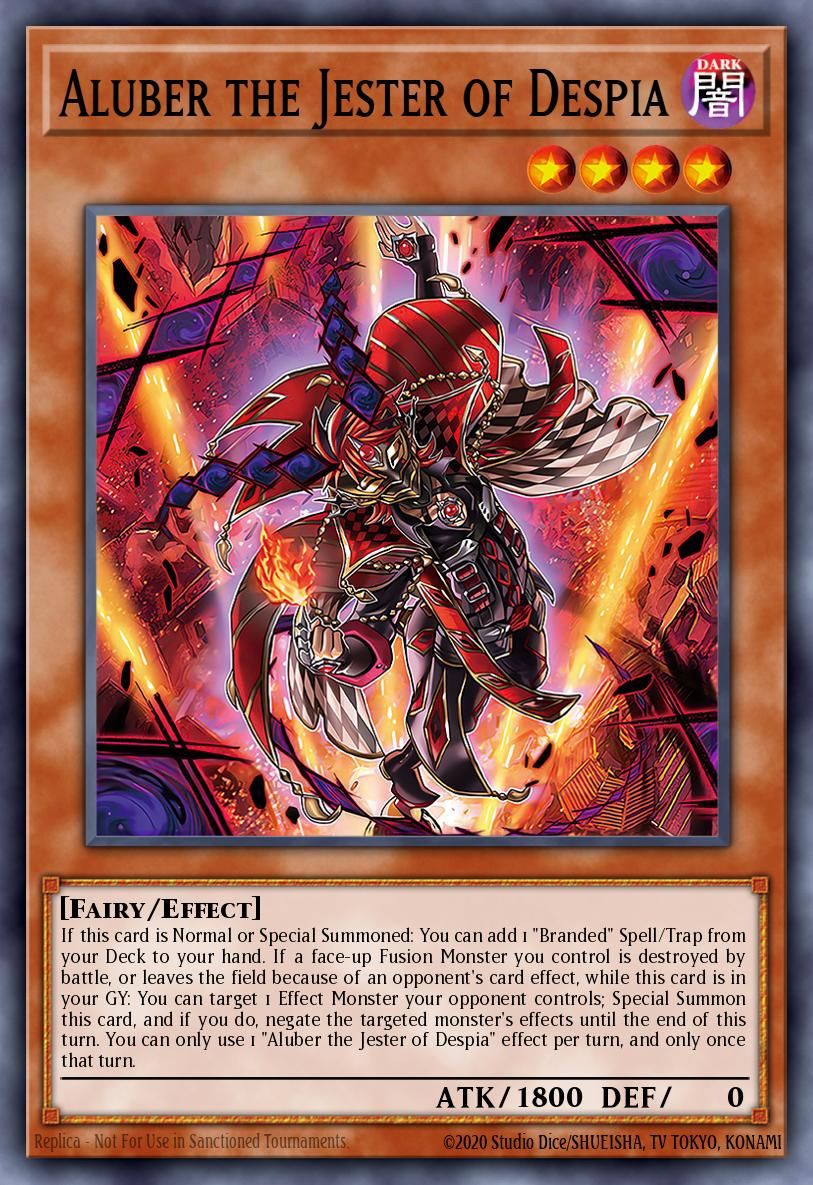
As of this article, the latest support has been from Burst of Destiny, and it is extremely likely for this archetype to receive even more relevant support.
Any other Despia main deck monsters not mentioned are either counterproductive to the game plan or simply useless. Although these members do not share any similar effects, they will all revolve around the importance of fusion summoning. Ideally, you would want to summon Aluber first to retrieve a spell for fusion summoning. Despian Tragedy is this deck's monster tutor, easily achievable by using Foolish Burial, Gold Sarcophagus, Allure of Darkness or simply using it as a fusion material! Dramaturge and Ad Libitum are both high level monsters that require additional effort to be summoned, but serve as fantastic fusion materials. Dramaturge can negate extra deck monsters while being a big body, and Ad Libitum can grant your monsters the additional boost needed to finish games quicker.
It is also worth noting that when these monsters are banished while used for fusing, they will still trigger. (from Branded in Red especially.) Despia can play through opposing Dimension Shifters to a certain degree.
Despia monsters excel better when used for fusion summoning, so constantly fusing them is the key to overwhelming advantage.
Leading Cast
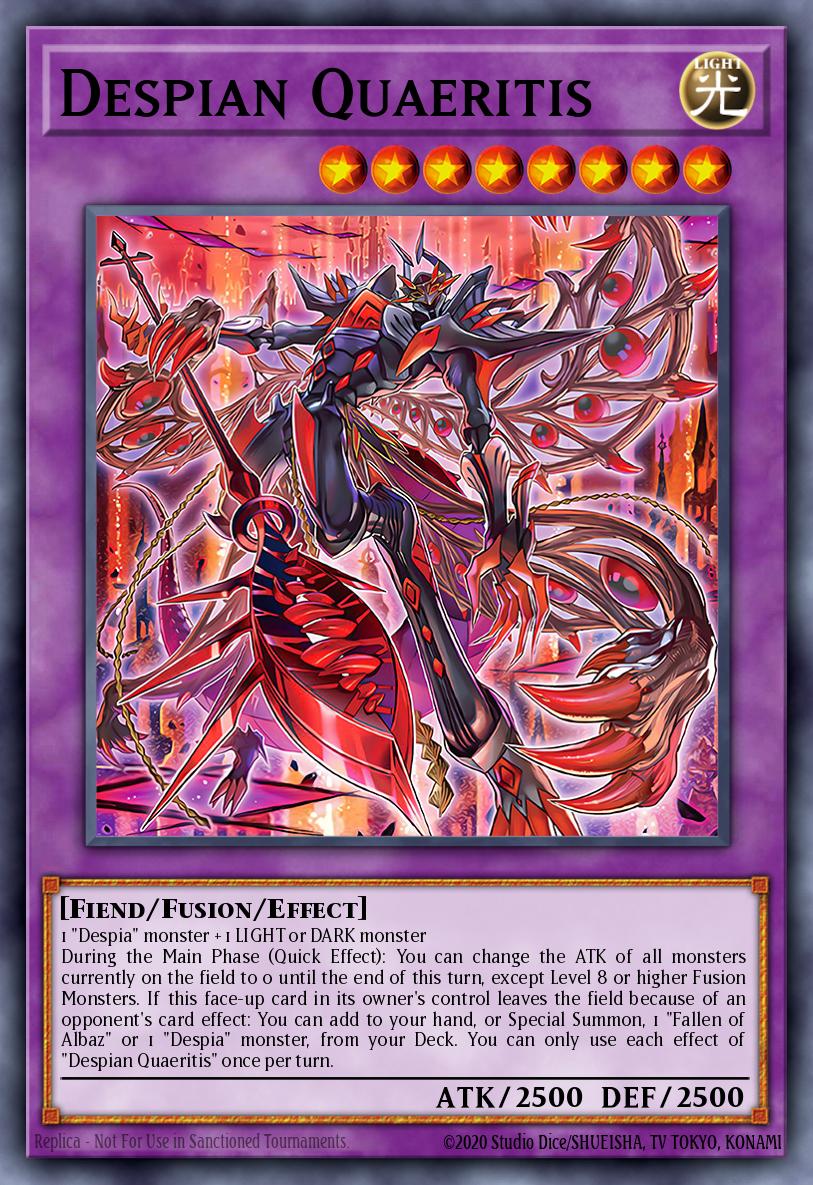
Aptly named after the legendary aspects of drama, these fusion monsters usually require only a singular Despia and Light/Dark monsters for their emergence. Despian Quaeritis is the titular fusion monster, with a nifty effect to set all lower beings to 0 ATK. More importantly, upon destruction, it will summon another Despian from the deck. Paired with both Aluber and the Despia Theater, this results in multiple bodies for your opponent to clear every turn.
Despian Proskenion is the deck's more offensive option with a heavier summoning cost. Proskenion punishes the opponent from deserting their extra deck options by either banishing or using them from their GY anytime. It also boasts significant stats, and deals heavy damage destroying opponent monsters. Along with Proskenion's necromancy, it is easy to conclude a game instantly with its presence.
Masquerade the Blazing Dragon contains a devastating burn effect that eventually builds up over time. Especially in a format where Verte Anaconda's 2000 LP cost is common, Masquerade the Blazing Dragon can edge the opponent towards a point where without enough LP, they simply can not activate any cards anymore. In addition, it has a nifty quick self-revival effect as an additional body.
These monsters may seem quite standard for your ideal fusion based archetype, but with the additional Branded spell/trap support from Burst of Destiny, Despia should be able to produce better results.
Supporting Section
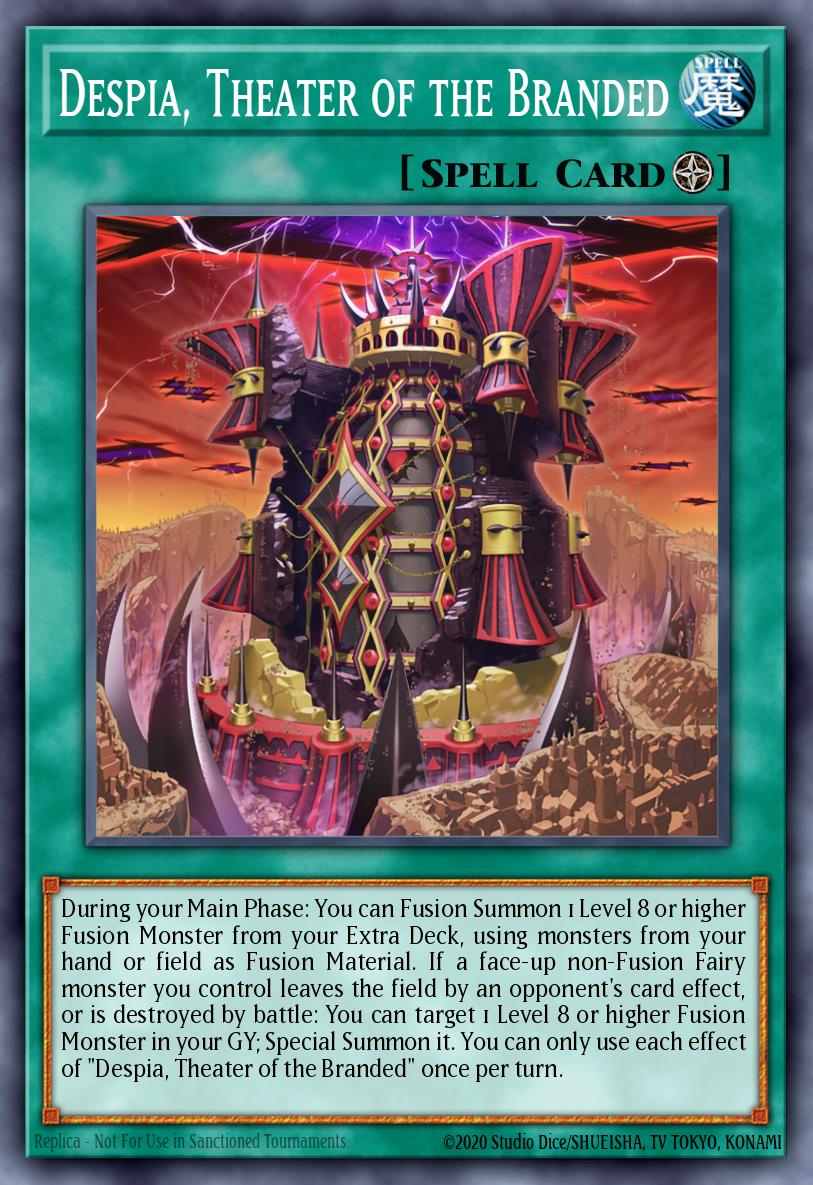
The Branded sub-archetype is normally meant for the use of Fallen of Albaz, but some of these specifically supports the Despia archetype better. Any other Branded cards not mentioned are either ineffective or lackluster.
Despia Theater and Branded in Red is this deck's method of fusion summoning. As a field spell, Despia Theater can perform fusion summons every turn efficiently while the quick-play Branded in Red can develop a disruptive fusion monster on the opposing turn. Notably, these fusion methods do not restrict the player to specifically Despia cards, so you can summon any other fusion monster.
Decklist Development
Despia strongly relies on the resolution of Despian Tragedy and Aluber to summon their impressive fusion monsters. In fact, Despia is able to tap into numerous generic fusion monsters easily, unlike other fusion archetypes. However, Despia suffers from having to use multiple resources to fuse while barely compensating its losses. Even if Despia is able to weather off multiple removals, they will eventually suffer from a lack of useful resources.
In order to supplement this fusion centric playstyle, it is advisable to consult other fusion related support. As such, below are some of my examples.
Despia
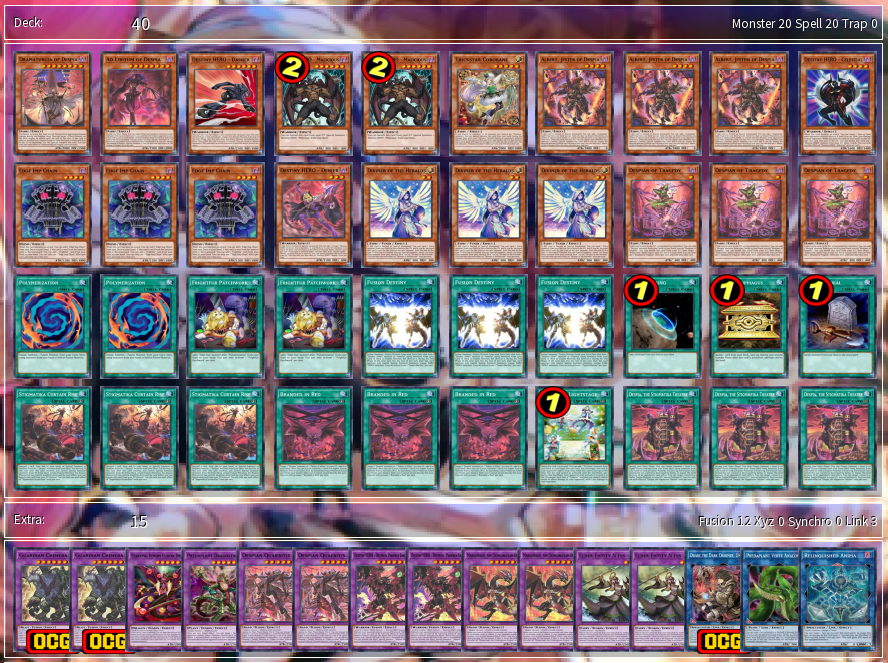
As a fusion-based archetype, Despia is granted the numerous benefits from other existing fusion-based predecessors. In this particular build, I have decided to mix in the Frightfur, Destiny HERO and Trickstar package.
Ideally when playing the "pure" build, your general game plan is to constantly trigger Despian Tragedy to generate resources. Despia Theater can summon Despian Quaeritis to weather out multiple spot removals, or Branded in Red can summon Guardian Chimera to disrupt your opponent turns. With the addition of Destroyer Phoenix Enforcer, this deck can output multiple destruction disruptions while still surviving several board wipes. Eventually, you will be able to push for game with multiple beefy fusion monsters.
The addition of Trickstar and Frightfur package grants this deck much needed additional resources. Despia is able to merge with many other supporting archetypes to cover its resource related weaknesses.
In addition to these techs, you may consider Fairy-related support like Protecting Spirit Loagaeth or other archetypes that allows more fusion summoning, such as this:
Shaddoll Despia
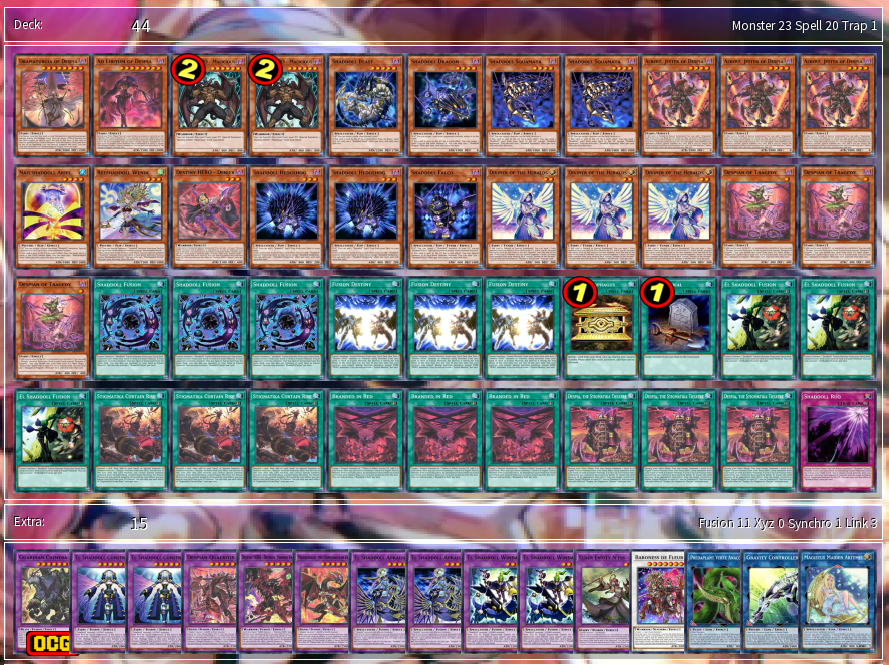
Shaddoll is one of the most impressive fusion archetypes to date. The Despia supports the Shaddoll style through Despia Theater where you can expect your Winda to never truly leave. The Despia and Shaddoll monsters trigger multiple beneficial effects being fused which forms a seamless synergy between the both.
Despia has proven itself to be able to merge with many other archetypes, so these examples should not be a limit of what they can do. In fact, I hope these provide a good starting point for you to consider various other choices to pair with.
Foiling the Forces
Despia is not a great deck by any means. It would be obvious to negate fusion summons, or any actions that lead towards it. Otherwise, you should be prudent to avoid an opposing Guardian Chimera, or risk playing into Masquerade the Blazing Dragon's continuous burn. As mentioned earlier, Despia suffers from eventual lack of resources, so surviving the initial waves does matter. Otherwise, look out for the other techs that your opponent has paired with Despia, as they could easily be more potent then Despia. By negating Aluber's search or any Branded spell, you will save yourself a lot of risk. But do cut Nibiru, Lancea and Dimension Shifter - they do absolutely nothing against this deck.
My Thoughts and Epilogue
Chaotic theatrical elements, epic artworks and an unreliable playstyle? Exactly what any rogue player desires. Despia has surfaced as a playable archetype, especially with the introduction of more powerful generic fusion monsters. This deck stands out amongst the other various fusion-centric decks in its own unique way with its recurring bodies and easy synergy. But personally, I just love seeing 2-3 purple monsters poke its way through the opponent's board without consequences.
I can easily foresee even more Despia support in the future, as this is merely the beginning of their story. Until then, I hope this article provides a great starting point to refer to.
